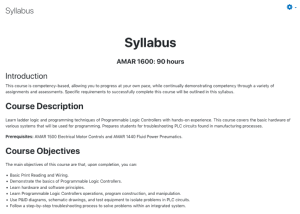Programmable Logic Controllers 1

Course Description:
This course, developed by Bridgerland Technical College, teaches students ladder logic and programming techniques of programmable logic controllers. The basic hardware of various systems that will be used for programming is covered. Upon completing the course, students should be able to:
- demonstrate basic print reading and wiring,
- demonstrate the basics of programmable logic controllers,
- learn hardware and software principles,
- learn programmable logic controllers operations, program construction, and manipulation,
- use P&ID diagrams, schematic drawings, and test equipment to isolate problems in PLC circuits, and
- follow a step-by-step troubleshooting process to solve problems within an integrated system.
Course Contents:
Course materials include a Canvas .imscc file. The .imscc file includes numerous folders and files from the Canvas course, including a syllabus. The syllabus includes a course description, course objectives, and instructor and grading information.
This course includes eight modules. Most modules include an introduction video, labs, and a discussion section.
Below is a sample of modules, labs, and quizzes included in this course:
- Module 0: Safety - 3 hours
- Safety Agreement Quiz
- Syllabus Page
- Module 1: Introduction to PLCs
- Quiz: PLC Familiarization
- Connect Your Computer to a MicroLogix PLC
- Lab 1-1: First System
- Module 2: Basic Instructions and Addresses
- Some Ladder Logic Programming Rules
- Lab 2-1: Fundamentals of PLC Logic
- Lab 2-2: Pneumatic System Overpressure Alarm
- Lab 2-3: Two Control Stations
- Lab 2-4: Hot Water Heater
- Lab 2-5: Typical PLC Motor Control System
- Lab 2-6: Filling Two Tanks
- Module 2: Output Bit Instructions
- Lab 2-7: Output Bit Instructions
- Lab 2-8: Scan Execution and the OTE Instructions
- Quiz: Lab 2-8 Questions
- Lab 2-9: Start/Stop for Two Motors
- Lab 2-10: 2 Conveyors With Disables
- Lab 2-11: A Reversing System
- Module 3: Timers and Counters
- Lab 3-1: Basic Timers
- Lab 3-2: Sequential Taillight
- Lab 3-3: Filling a Grain Bin, Revisited
- Lab 3-4: Basic Counters
- Lab 3-5: Cooling Rack
- Lab 3-6: A Pumping Process
- Module 03: The B3 File (Bits)
- Lab 3-7: Using B3 Bits
- Lab 3-8: Machine With Lubricated Bearing
- Lab 3-9: A Rotation Sensor
- Quiz: Module 3
- Module 4: Program Control
- Module 04: Subroutines
- Lab 4-1: Intro to Subroutines
- Lab 4-2: Motor Rung With Auto/Manual
- Lab 4-3: Alarms
- Module 5: Math Instructions
- Lab 5-1: Basic Math Functions
- Lab 5-2: Action on a Sum of Counters
- Lab 5-3: Convert Celsius to Fahrenheit
- Lab 5-4: Build Your Own Counter
- Lab 5-5: Beverage Can Production
- Module 6: Sequencers
- Module 06: Binary Numbers
- Lab 6-1: Counting in Binary
- Module 06: Hexadecimal Numbers
- Lab 6-2: Manipulating Bits (and Outputs) in Groups
- Module 6: Sequencer (SQO) Instruction
- Lab 6-3: Sequential Tail Light, Revisited
- Lab 6-4: Car Wash
- Module 7: Final Project
- Final Lab: Traffic Intersection
- Module 7: Troubleshooting Discussion
- Module 8: Troubleshooting PLC Circuits
- Simutech - Troubleshooting PLC Circuits
- Basic Level Troubleshooting
- Intermediate Level Troubleshooting
- Advanced Level Troubleshooting
- Certificate of Completion
About this Resource

Comments